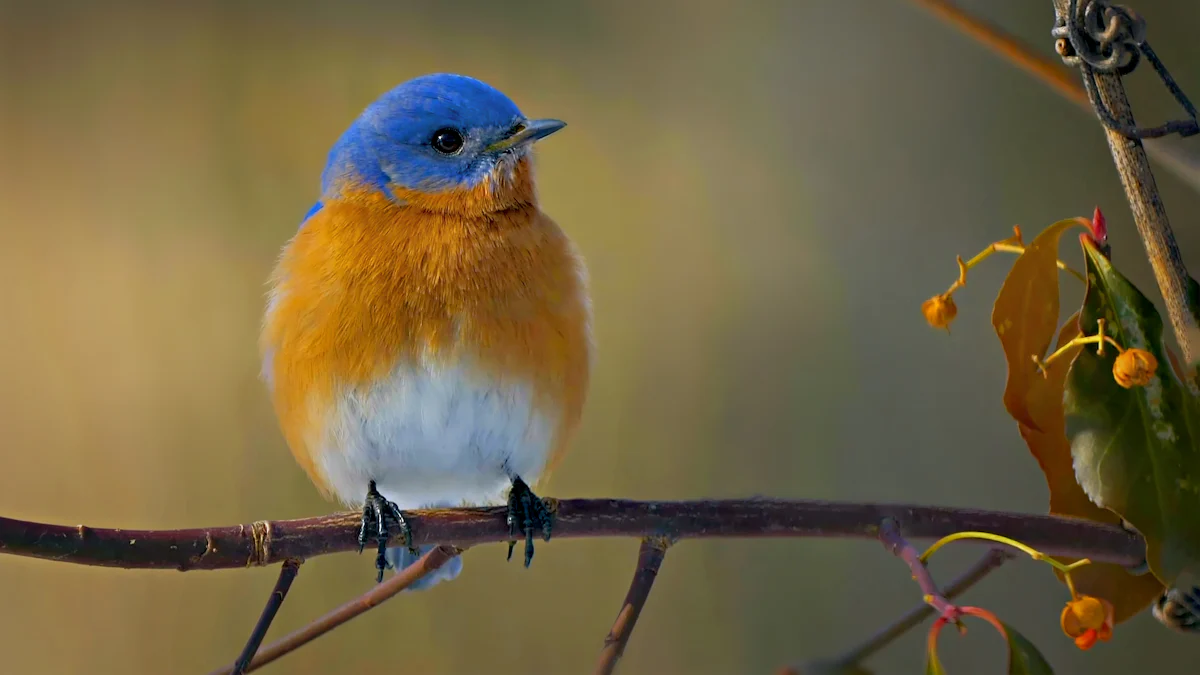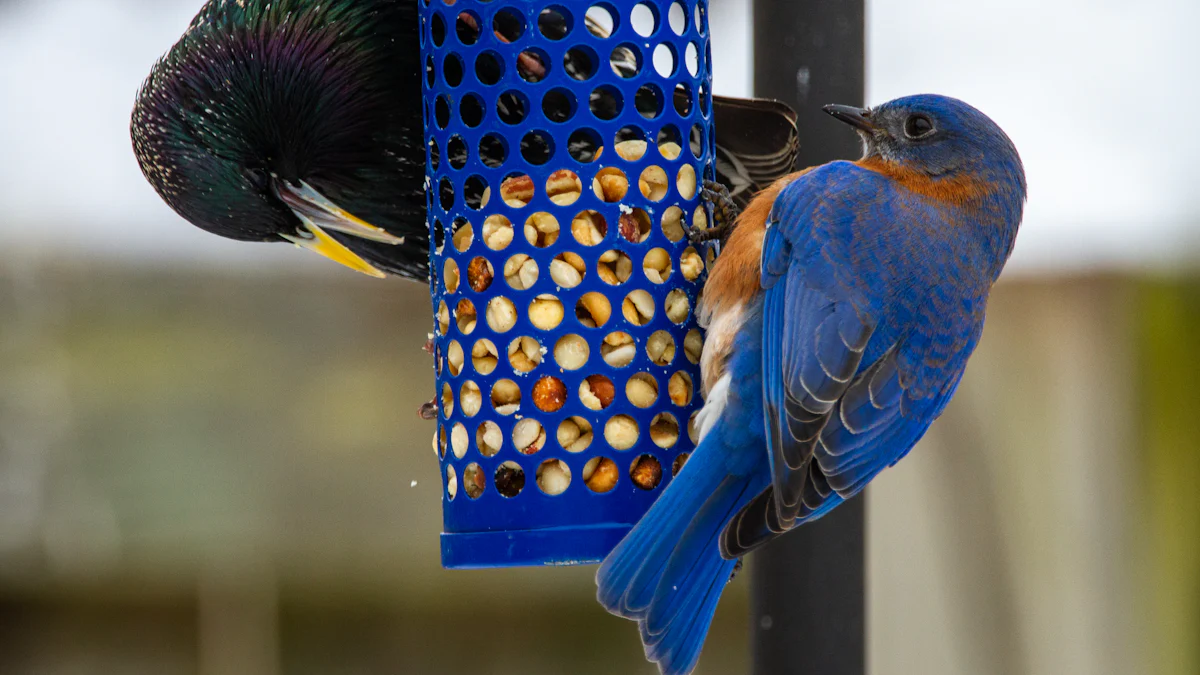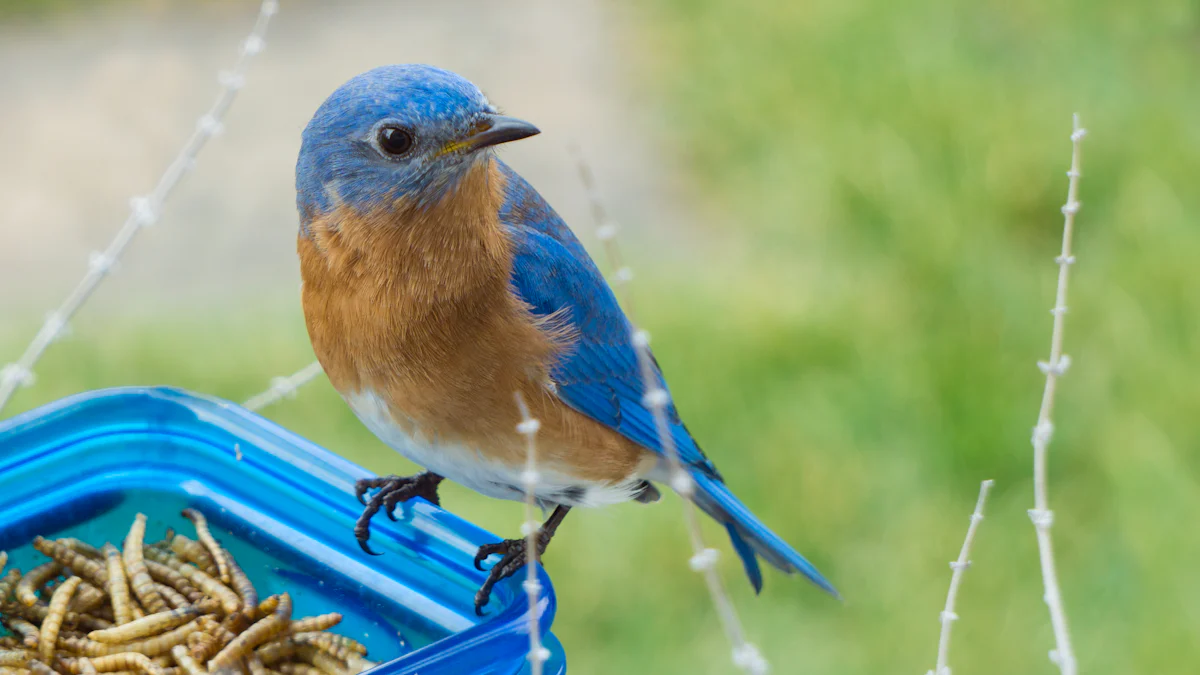
Mealworms for birds are a powerhouse of nutrition. They deliver over 50% protein, essential fats, and fiber, ensuring a balanced diet. Birds thrive on this energy boost, especially during breeding or migration. It’s incredibly easy! Simply mix the mealworms for birds into your regular bird seed mix or provide them alone in a dish or hopper feeder. Watch the birds flock to enjoy this treat!
Key Takeaways
- Mealworms are healthy for wild birds. They have over 50% protein, good fats, and fiber. These give birds energy, especially during breeding and migration times.
- Give mealworms in small amounts. Feed them more often during nesting or cold weather. Do not overfeed to avoid health problems or pests.
- Pick the right feeder for mealworms. Tray, dish, or hanging feeders are good options. Make sure the feeder keeps mealworms inside and safe from weather.
Benefits of Mealworms for Birds

Nutritional Value and Protein Content
Mealworms are a nutritional powerhouse for wild birds. They’re packed with protein, fat, and fiber, which are essential for bird health. The protein content in mealworms is especially impressive. Live mealworms contain about 20% protein, while dried mealworms boast a whopping 53%. This makes them one of the best protein sources compared to other common bird foods.
Here’s a quick breakdown of their nutrients:
| Nutrient | Live Mealworms | Dried Mealworms |
|---|---|---|
| Protein | 20% | 53% |
| Fat | 13% | 28% |
| Fiber | 2% | 6% |
| Moisture | 62% | 5% |
Mealworms also provide essential amino acids that support feather growth and overall vitality. Plus, they’re rich in B vitamins like B12 and B2, which help birds convert food into energy. This keeps them active and ready to explore your yard.
Seasonal Benefits for Breeding and Migration
Mealworms for birds are especially valuable during breeding and migration seasons. In spring, they provide the nutrients parent birds need to raise their chicks. During migration, mealworms offer a high-protein, high-fat energy boost that helps birds travel long distances. They’re also a lifesaver in winter when natural food sources are scarce. Offering mealworms during these critical times can make a big difference in a bird’s survival and success.
Bird Species That Prefer Mealworms
Many bird species love mealworms. Bluebirds, robins, and chickadees are some of the most common visitors to mealworm feeders. Orioles, woodpeckers, and wrens also enjoy this tasty treat. In urban areas, bluebirds and robins are frequently spotted feeding on mealworms. Whether you live in the city or the countryside, adding mealworms to your bird-feeding routine can attract a variety of feathered friends to your yard.
Feeding Mealworms to Wild Birds
How Often to Feed Mealworms
Feeding wild birds mealworms requires balance. Offering them occasionally in small amounts works best. During spring, when birds are laying eggs and feeding their young, their protein needs increase. This is the perfect time to provide mealworms more frequently. In colder months, birds also benefit from the extra energy mealworms provide. However, moderation is key. Overfeeding can lead to health issues like obesity or digestive problems. It may also attract predators or disrupt birds’ natural foraging habits.
Here’s a quick guide:
- Feed mealworms more often during nesting or cold seasons.
- Offer small quantities to avoid waste and overfeeding.
- Adjust feeding based on bird activity in your area.
Live vs. Dried Mealworms
Choosing between live and dried mealworms depends on your goals and the season. Live mealworms are highly appealing to birds. Their movement triggers hunting instincts, making them a favorite during nesting or hot weather when hydration is crucial. On the other hand, dried mealworms are practical and economical. They last longer, store easily, and still pack a nutritional punch.
Consider these points:
- Live Mealworms: Provide moisture, amino acids, and vitamins but cost more and require careful storage.
- Dried Mealworms: High in protein and fats, with a longer shelf life, making them ideal for winter feeding.
Both types can attract unwanted predators, so it’s wise to feed in moderation.
Seasonal Feeding Tips
Adjusting your feeding routine with the seasons ensures birds get the nutrients they need. In spring, increase mealworm offerings to support egg-laying and chick-rearing. During winter, add extra fat to help birds stay warm. Dried mealworms work well year-round but should be offered in small amounts. By tailoring your approach, you’ll keep birds healthy and thriving throughout the year.
Choosing the Best Feeders for Mealworms

Types of Feeders for Mealworms
Selecting the right feeder makes a big difference when offering mealworms to wild birds. Tray feeders are a popular choice because of their open design, which attracts a variety of bird species. Dish feeders are another great option. Their compact size allows for close viewing, making them perfect for birdwatchers with limited space. Hanging feeders work well too. They can be suspended from branches or poles, keeping mealworms off the ground and away from pests.
When choosing a feeder, look for features that prevent mealworms from escaping. Tall sides are essential for keeping the mealworms contained. A roof or baffle protects the food from rain, while drainage holes prevent water from pooling. Tamper-resistant designs also help keep pests like squirrels and raccoons at bay.
Placement and Accessibility
Where you place your feeder matters. Position feeders in quiet areas to attract birds without scaring them away. Keep them at a height that’s easy for birds to reach but out of reach for ground pests. For example, hanging feeders work well for keeping mealworms safe from raccoons. Avoid placing feeders in high-traffic areas or spots prone to moisture. This ensures birds can feed comfortably and safely.
Maintenance and Cleaning
Regular cleaning keeps feeders safe and hygienic for birds. Wash feeders every two weeks with mild soap and water. Scrub off debris, then let them dry completely before refilling. For a deeper clean, soak feeders in a diluted bleach solution (one part bleach to nine parts water) for ten minutes. This helps prevent the spread of diseases like salmonella. Keeping feeders clean ensures a healthy feeding environment for your feathered visitors.
Proper Storage of Mealworms
Storing Live Mealworms Safely
Keeping live mealworms fresh and healthy requires careful storage. They thrive in cool environments, so aim for a temperature range between 50°F and 70°F (10°C to 21°C). A breathable container, like one with small holes or a mesh lid, works best. This allows proper ventilation while preventing them from escaping. Avoid humid areas, as moisture can lead to mold or bacterial growth.
Here’s a quick guide to storing live mealworms:
- Use a breathable container to ensure airflow.
- Keep them in a cool, dry place, away from direct sunlight.
- Check regularly for signs of spoilage, such as a bad smell or unusual texture.
- Replace the substrate (like oats or bran) every few weeks to maintain cleanliness.
- Purchase mealworms from trusted suppliers to ensure quality.
By following these steps, you’ll keep your mealworms safe and ready to feed your feathered visitors.
Storing Dried Mealworms to Prevent Spoilage
Dried mealworms are easier to store than live ones, but they still need proper care to stay fresh. Always keep them in a cool, dry place, ideally at room temperature. Airtight containers are essential for preventing moisture and pests. Adding desiccants or moisture-absorbing packets can help manage humidity.
Dried mealworms stored correctly can last several months to a year without losing their nutritional value.
For long-term storage, freezing dried mealworms at temperatures below -15°C is a great option. This method preserves their freshness and prevents spoilage. Regularly check for changes in odor or texture, as these can indicate contamination. Cleaning the storage container every two weeks also helps prevent mold or bacteria from forming.
Tips to Avoid Contamination
Contamination can ruin your mealworms and harm the birds you’re feeding. To avoid this, store mealworms in a clean, dry environment. Use containers with proper ventilation, such as those with small holes or mesh lids. Inspect the mealworms regularly for signs of mold, mites, or waste.
Follow these tips to keep mealworms safe:
- Clean storage containers every two weeks to remove debris and bacteria.
- Replace the substrate periodically to prevent mold and bacteria buildup.
- Keep mealworms in a cool, dry place to avoid attracting pests.
- Purchase from reputable sources to ensure high-quality products.
By taking these precautions, you’ll provide a safe and nutritious treat for wild birds while keeping your storage hassle-free.
Where to Source Mealworms for Birds
Online Retailers and Trusted Brands
Buying mealworms online is a convenient option for many bird enthusiasts. Several reliable retailers offer high-quality mealworms that cater to wild birds’ nutritional needs. Popular platforms like Amazon and eBay provide a wide selection of both live and dried mealworms. Specialized insect-keeping stores also stock mealworms, often with detailed care instructions.
For those looking for a trusted source, Uncle Jim’s Worm Farm is a standout choice. They specialize in live mealworms, ensuring they arrive fresh and ready to feed your feathered visitors. Shopping online also allows you to compare prices and read reviews, helping you make an informed decision.
🛒 Tip: When ordering online, check for bulk options to save money and ensure a steady supply for your birds.
Local Stores and Garden Centers
Local stores and garden centers are excellent places to source mealworms. They often provide the opportunity to interact directly with sellers, allowing you to ask questions about farming methods or the quality of the mealworms. Some local vendors even offer organic mealworms, which can be a more sustainable choice.
Purchasing locally also supports small businesses and reduces the environmental impact of shipping. Many garden centers stock mealworms alongside bird feeders and other supplies, making it easy to pick up everything you need in one trip.
🌱 Note: By buying from local stores, you contribute to sustainable practices and support your community.
How to Choose High-Quality Mealworms
Not all mealworms are created equal. Choosing high-quality ones ensures your birds get the best nutrition. Dried mealworms are a great option, offering over 50% protein along with essential fats and fiber. They’re perfect for times when natural food sources are scarce. Live mealworms, on the other hand, provide hydration due to their moisture content, making them ideal during hot weather or nesting seasons.
Here’s what to look for:
- Dried Mealworms: Store them in airtight containers in a cool, dry place to maintain freshness.
- Live Mealworms: Keep them in a ventilated container with bedding material and store in a cool environment.
- Moderation: Feed mealworms in small amounts to avoid attracting predators or disrupting local ecosystems.
Providing a variety of food sources alongside mealworms ensures a balanced diet for wild birds. This approach keeps them healthy and encourages natural foraging behaviors.
🐦 Tip: Always inspect mealworms for signs of spoilage or contamination before feeding them to birds.
Feeding mealworms to wild birds is incredibly easy! Mix them into your regular bird seed or serve them alone in a dish or hopper feeder. Dried mealworms provide a perfect balance of protein, fat, and fiber, promoting healthy, active birds. Start today and enjoy the beauty of feathered visitors flocking to your yard!
FAQ
How do I mix mealworms with bird seed?
Mix a handful of dried mealworms into your regular bird seed. Use a dish or hopper feeder to serve. Birds will love the added protein boost!
Can mealworms attract unwanted pests?
Yes, mealworms can attract pests like raccoons or squirrels. Use tamper-resistant feeders and avoid overfeeding. Clean up spilled mealworms to keep your feeding area pest-free.
Are mealworms safe for all bird species?
Mealworms are safe for most wild birds, including bluebirds and robins. However, avoid overfeeding to ensure birds maintain a balanced diet and natural foraging habits.
🐦 Tip: Always monitor bird activity to adjust mealworm portions and prevent waste.


